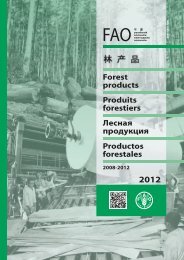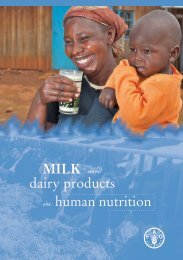Create successful ePaper yourself
Turn your PDF publications into a flip-book with our unique Google optimized e-Paper software.
XXI<br />
Industrial Roundwood-Wood in the Rough<br />
Industrial Roundwood-Wood in the Rough (C)<br />
Industrial Roundwood-Wood in the Rough (NC)<br />
Industrial Roundwood-Wood in the Rough (NC) Tropical<br />
Industrial Roundwood-Wood in the Rough (NC) Other<br />
Roundwood that will be used in the production of other goods<br />
and services (except as a source of fuel). It includes: all<br />
roundwood except wood fuel. In the production statistics, it<br />
represents the sum of: sawlogs and veneer logs; pulpwood,<br />
round and split; and other industrial roundwood. Trade statistics<br />
for this category are only divided into coniferous and nonconiferous<br />
(and the latter is further subdivided into tropical and<br />
non-tropical). It is reported in cubic metres underbark (i.e.<br />
excluding bark).<br />
Sawlogs and Veneer Logs<br />
Sawlogs and Veneer Logs (C)<br />
Sawlogs and Veneer Logs (NC)<br />
Roundwood that will be sawn (or chipped) lengthways for the<br />
manufacture of sawnwood or railway sleepers (ties) or used for<br />
the production of veneer (mainly by peeling or slicing). It<br />
includes: roundwood (whether or not it is roughly squared) that<br />
will be used for these purposes; shingle bolts and stave bolts;<br />
match billets and other special types of roundwood (e.g. burls<br />
and roots, etc.) used for veneer production. It is reported in<br />
cubic metres underbark (i.e. excluding bark).<br />
Pulpwood, Round and Split<br />
Pulpwood, Round and Split (C)<br />
Pulpwood, Round and Split (NC)<br />
Roundwood that will be used for the production of pulp,<br />
particleboard or fibreboard. It includes: roundwood (with or<br />
without bark) that will be used for these purposes in its round<br />
form or as splitwood or wood chips made directly (i.e. in the<br />
forest) from roundwood. It is reported in cubic metres<br />
underbark (i.e. excluding bark).<br />
Other Industrial Roundwood<br />
Other Industrial Roundwood (C)<br />
Other Industrial Roundwood (NC)<br />
Roundwood that will be used outside the forest processing sector<br />
for the production of other goods and services (except as a<br />
source of fuel). It includes: roundwood that will be used for<br />
tanning, distillation, match blocks, gazogenes, poles, piling,<br />
posts, fencing and pitprops, etc. It is reported in cubic metres<br />
underbark (i.e. excluding bark).<br />
WOOD CHARCOAL, WOOD CHIPS, PARTICLES AND<br />
RESIDUES<br />
Wood Charcoal<br />
Wood carbonised by partial combustion or the application of<br />
heat from external sources. It includes: charcoal used as a<br />
fuel or for other uses, e.g. as a reduction agent in metallurgy or<br />
as an absorption or filtration medium. It is reported in metric<br />
tons.<br />
Wood Chips and Particles<br />
Wood that has been deliberately reduced to small pieces during<br />
the manufacture of other wood products and is suitable for<br />
pulping, for particle board and fibreboard production, for use as a<br />
fuel, or for other purposes. It excludes: wood chips made<br />
directly (i.e. in the forest) from roundwood (i.e. already counted<br />
as pulpwood or wood fuel). It is reported in cubic metres solid<br />
volume excluding bark.<br />
Wood Residues<br />
The volume of roundwood that is left over after the production of<br />
forest products in the forest processing industry (i.e. forest<br />
processing residues) and that has not been reduced to chips or<br />
particles. It includes: sawmill rejects, slabs, edgings and<br />
trimmings, veneer log cores, veneer rejects, sawdust, residues<br />
from carpentry and joinery production, etc. It excludes: wood<br />
chips made either directly (i.e. in the forest) from roundwood or<br />
made from residues (i.e. already counted as pulpwood, round<br />
and split or wood chips and particles). It is reported in cubic<br />
metres solid volume excluding bark.<br />
SAWNWOOD<br />
Sawnwood<br />
Sawnwood (C)<br />
Sawnwood (NC)<br />
Wood that has been produced from both domestic and imported<br />
roundwood, either by sawing lengthways or by a profile-chipping<br />
process and that, with a few exceptions, exceeds 5 mm in<br />
thickness. It includes: planks, beams, joists, boards, rafters,<br />
scantlings, laths, boxboards, sleepers and "lumber", etc., in the<br />
following forms: unplaned, planed, grooved, tongued, fingerjointed,<br />
chamfered, rabbeted, V-jointed, beaded, etc. It<br />
excludes: wooden flooring. It is reported in cubic metres solid<br />
volume.<br />
WOOD-BASED PANELS<br />
Wood-Based Panels<br />
The wood-based panels category is an aggregate category. In<br />
the production and trade statistics, it represents the sum of:<br />
veneer sheets, plywood, particle board, and fibreboard. Until<br />
1995, fibreboard was further split into compressed fibreboard<br />
and non-compressed fibreboard. Starting from 1995 the<br />
compressed fibreboard category has been disaggregated into<br />
hardboard and medium density fibreboard (MDF); and noncompressed<br />
fibreboard has been re-labelled as insulating board.<br />
It is reported in cubic metres solid volume.<br />
Veneer Sheets<br />
Thin sheets of wood of uniform thickness, rotary cut (i.e. peeled),<br />
sliced or sawn. It includes: wood used for the manufacture of<br />
plywood, laminated construction material, furniture, veneer<br />
containers, etc. It excludes: wood used for plywood production<br />
within the same country. It is reported in cubic metres solid<br />
volume.<br />
Plywood<br />
A panel consisting of an assembly of veneer sheets bonded<br />
together with the direction of the grain in alternate plies generally<br />
at right angles. The veneer sheets are usually placed<br />
symmetrically on both sides of a central ply or core which may<br />
itself be made from a veneer sheet or another material. It<br />
includes: veneer plywood (plywood manufactured by bonding<br />
together more than two veneer sheets, where the grain of<br />
alternate veneer sheets is crossed, generally at right angles);<br />
core plywood or blockboard (plywood with a solid core (i.e. the<br />
central layer, generally thicker than the other plies) that consists<br />
of narrow boards, blocks or strips of wood placed side by side,<br />
which may or may not be glued together); cellular board<br />
(plywood with a core of cellular construction); and composite<br />
plywood (plywood with the core or certain layers made of<br />
material other than solid wood or veneers). It excludes:<br />
laminated construction materials (e.g. glulam), where the grain of<br />
the veneer sheets generally runs in the same direction. It is<br />
reported in cubic metres solid volume.<br />
Particle Board<br />
A panel manufactured from small pieces of wood or other lignocellulosic<br />
materials (e.g. chips, flakes, splinters, strands, shreds,<br />
shives, etc.) bonded together by the use of an organic binder<br />
together with one or more of the following agents: heat, pressure,<br />
humidity, a catalyst, etc. It includes: waferboard; oriented<br />
strandboard (OSB) and flaxboard. It excludes: wood wool and<br />
other particle boards bonded together with inorganic binders. It<br />
is reported in cubic metres solid volume.<br />
Fibreboard<br />
A panel manufactured from fibres of wood or other lignocellulosic<br />
materials with the primary bond deriving from the felting<br />
of the fibres and their inherent adhesive properties (although<br />
bonding materials and/or additives may be added in the<br />
manufacturing process). It includes: fibreboard panels that are<br />
flat-pressed and moulded fibreboard products. In the<br />
production and trade statistics, it represents the sum of:<br />
hardboard; medium density fibreboard (MDF); and insulating<br />
board. It is reported in cubic metres solid volume.







